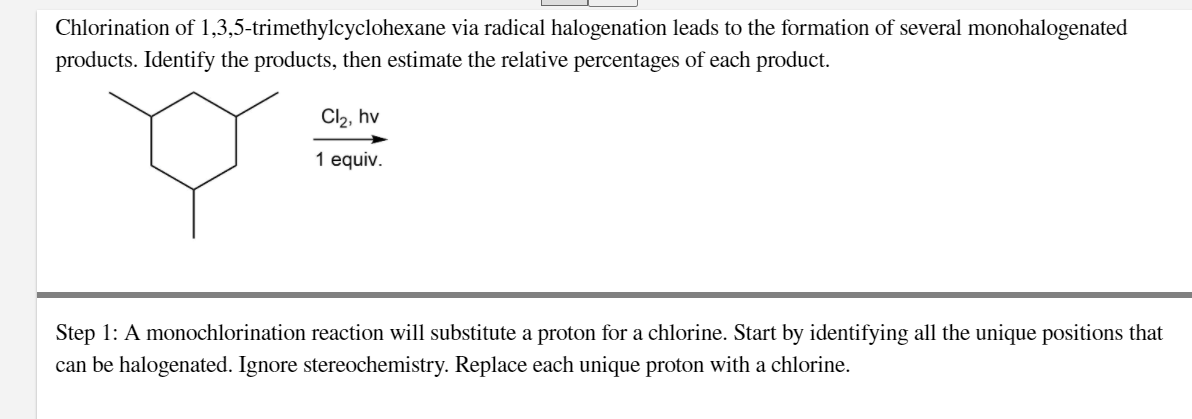Chlorination of 1,3,5‑trimethylcyclohexane via radical halogenation leads to the formation of several monohalogenated products. Identify the products, then estimate the relative percentages of each product. Step 1: A monochlorination reaction will substitute a proton for a chlorine. Start by identifying all the unique positions that can be halogenated. Ignore stereochemistry
Chlorination of 1,3,5‑trimethylcyclohexane via radical halogenation leads to the formation of several monohalogenated products. Identify the products, then estimate the relative percentages of each product. Step 1: A monochlorination reaction will substitute a proton for a chlorine. Start by identifying all the unique positions that can be halogenated. Ignore stereochemistry
Chapter10: Organohalides
Section10.SE: Something Extra
Problem 24AP: Draw and name all of the monochlorination products that you might obtain from the radical...
Related questions
Question
Chlorination of 1,3,5‑trimethylcyclohexane via radical halogenation leads to the formation of several monohalogenated products. Identify the products, then estimate the relative percentages of each product.
Step 1: A monochlorination reaction will substitute a proton for a chlorine. Start by identifying all the unique positions that can be halogenated. Ignore stereochemistry. Replace each unique proton with a chlorine.

Transcribed Image Text:Chlorination of 1,3,5-trimethylcyclohexane via radical halogenation leads to the formation of several monohalogenated
products. Identify the products, then estimate the relative percentages of each product.
Cl2, hv
1 equiv.
Step 2: Replace each unique secondary proton with a chlorine.

Transcribed Image Text:Chlorination of 1,3,5-trimethylcyclohexane via radical halogenation leads to the formation of several monohalogenated
products. Identify the products, then estimate the relative percentages of each product.
Cl2, hv
1 equiv.
Step 1: A monochlorination reaction will substitute a proton for a chlorine. Start by identifying all the unique positions that
can be halogenated. Ignore stereochemistry. Replace each unique proton with a chlorine.
Expert Solution
This question has been solved!
Explore an expertly crafted, step-by-step solution for a thorough understanding of key concepts.
This is a popular solution!
Trending now
This is a popular solution!
Step by step
Solved in 3 steps with 2 images

Knowledge Booster
Learn more about
Need a deep-dive on the concept behind this application? Look no further. Learn more about this topic, chemistry and related others by exploring similar questions and additional content below.Recommended textbooks for you


Organic Chemistry
Chemistry
ISBN:
9781305580350
Author:
William H. Brown, Brent L. Iverson, Eric Anslyn, Christopher S. Foote
Publisher:
Cengage Learning


Organic Chemistry
Chemistry
ISBN:
9781305580350
Author:
William H. Brown, Brent L. Iverson, Eric Anslyn, Christopher S. Foote
Publisher:
Cengage Learning